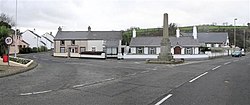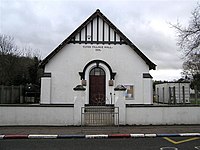Glynn
| Glynn | |
| County Antrim | |
|---|---|
 Glynn | |
| Location | |
| Grid reference: | J407999 |
| Location: | 54°49’40"N, 5°48’40"W |
| Data | |
| Post town: | Larne |
| Postcode: | BT40 |
| Local Government | |
| Council: | Mid & East Antrim |
Glynn is a small village in County Antrim, a short distance south of Larne, on the shore of Larne Lough. Glynn had a population of 2,027 people at the 2011 Census.
History
The Church of Gluaire is supposed to have been founded by St Patrick in the year 435. The ruins of an old stone church still stand within the village boundary. Before baronial division, the county of Antrim was divided into the districts of North Clandeboye and Glynns (Glynnes). The area was a vicarage in the Diocese of Connor and ecclesiastical province of Armagh and was a gift of the Marquess of Donegall.
The village is then mentioned in a grant from King James I to Arthur Lord Chichester, Baron of Belfast, of his estates in Antrim, Down and Carrickfergus. This grant was dated 20 November 1620. In a later grant from King Charles II to Edward, Viscount Chichester, Glynn was mentioned as being part of the territory of Magheramorne.
Written information exists that details how Sir John Chichester, governor of Carrickfergus, was beheaded by James MacSorley MacDonnell at a site on the eastern edge of the village. James MacDonnell and his men had made a feint on Carrickfergus town. They were then pursued to the glen of Altrackyn, some five miles from Glynn. Sir John was captured and his men were nearly cut to pieces. Later in the day, Sir John was beheaded by James MacDonnell on a stone. It is documented that this event occurred in November 1597. A 'standing stone' still stands to this day, approximately one mile east of the village.
In the early 20th century the lime works and Ballylig was bought by Associated Portland Cement Manufacturers (now Blue Circle) and a large cement works was built alongside the wharf. The works became a significant employer in the wider area.
In the 1930s Glynn, was seen on the big screen in the film The Luck Of The Irish, which starred the Hollywood actor Richard Hayward, and many villagers were used as extras.
From the 1930s Glynn saw expansion with many of the thatched cottages being replaced by modern family housing. The first phase was approximately 100 houses and bungalows at Glenvale Park, build in the 1950s. Then, in the late 1960s, eighteen houses were built at Glenside. These were followed by more houses and bungalows at Hawthorne Grove in the 1970s. All these properties were built by the government for renting. Further housing developments have taken place in the 1980s at Glenavon and in the 1990s at Craiganboy. The latter two developments were built privately for sale. It is estimated that there are now approximately 350 occupied dwelling houses in Glynn (April 2004).
Glynn has seen new housing developments in the latter half of 2006, where several bungalows were built on the Glenburn Road and adjacent the Jubilee park behind Hawthorne Grove estate. A plot of field near to the Main Road was also purchased in December 2006 for a more than ample sum of £250, 000; no plans of layout for housing have been confirmed yet. The compound area at the foot of the Glynn Brae is also rumoured to undergo changes this year in becoming a future housing estate.

Places of interest
Out in Larne Lough lies Swan Island. There are actually two small islands, one of which has been a bird sanctuary for many years. The larger of the two islands measures approximately fifty yards in length by fifteen yards in width. It is covered in grass, shingle and sand. The smaller of the two islands can only be seen at low tide. In times gone by the larger island was called Pigeon Island and then Duck Island. It was let in the early 19th century for one guinea per annum to burn kelp.
According to the records from the 19th century; The large Swan Isle is said to contain the bodies of the crew of some foreign ships who died of some plague, while the ships were laid under quarantine in Larne Lough, and would not be permitted to enter the harbour. The smaller island was supposed to be where the bodies of the dead sailors were burnt before burial on the larger island.
Today Swan Island and the lough shore at Glynn draws ornithologists from near and far. Birdwatchers come to see birds like swans, gulls, terns, oystercatchers and sandpipers.
Landowners
In the 18th and 19th centuries the 'proprietors' within the wider parish were John Irving Esquire, M.P., who lived at Ballylig House, Magheramorne. John Irving owned lime kilns and wharfs at Magheramore and extensive lands and property in the area. His agent, Thomas Maxwell Esquire, J.P., lived in a plain but modern house, overlooking Larne Lough, approximately one mile north of Glynn. Ballylig House still stands and was better known a few years ago as Magheramorne House Hotel. More recently however, the house has been the Ireland Head Office for Forever Living Products (Ireland) Ltd. The former house of Thomas Maxwell also still stands and is privately owned.
Within Glynn village, Randall William Johnston Esquire was the owner of mills, public buildings, houses and land. Mr Johnston was a descendent of an officer in King William's army.
Public transport
Glynn lies on a suburban rail route from Belfast to Larne. Glynn railway station opened on 1 January 1864 and was closed for goods traffic in 1933.[1]
Jubilee Park
In the summer of 2008 work began on the refurbishment of Jubilee Park. Time had taken its toll on the children's play area, opened in June 1977 to celebrate Queen Elizabeth II Silver Jubilee, and it was in desperate need of a makeover. Local contractors came together to provide a modern, colourful and safe environment for the next generation of children to play in. The new park was finally completed and opened in early September 2008, coinciding with the beginning of the new school term.
Outside links
References
- ↑ "Glynn (Antrim)" (PDF). Railscot - Irish Railways. http://www.railscot.co.uk/Ireland/Irish_railways.pdf. Retrieved 2007-08-28.